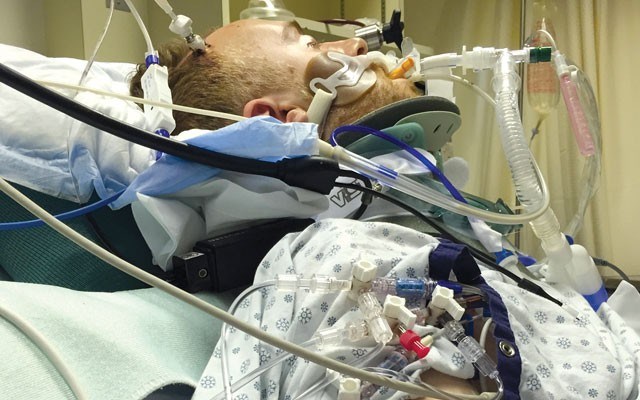In May 2016, Michael Severloh was biking to Vancouver's Emily Carr University of Art + Design when he was struck by a car. The 30-year-old slammed into the windshield, flew over six metres, then crashed into the ground.
Yet despite the severity of his brain injury — according to his acting physician, crashes like his typically result in death or permanent brain damage — Severloh's recovery has been smooth and steady. Since his accident, Severloh has relearned how to walk, began to drive, and settled into the familiar rhythms of life with his wife Janis, family and friends.
And next fall — just over a year after the trauma — he'll return to university full time.
He owes his recovery, he said, to two things: Wearing his helmet, and Vancouver General Hospital's (VGH) head-injury treatment program.
"I'd never want it to happen to anybody," reflected Severloh. "But if you're going to get a head injury, Vancouver's the place to do it — they're set up for it."
Since 2015, the VGH team has been using a new technique — known as advanced multimodal neuromonitoring — to treat severe head injuries. The approach was developed at the University of Cambridge and was brought to VGH by Dr. Mypinder Sekhon, a critical-care physician who spent two years studying the method in England.
The results, said Sekhon, have been "pretty striking." A Canadian Journal of Neurological Sciences study reported that patients who received the treatment at VGH were 2.5 times more likely to have full neurological recovery after six months than patients who received conventional treatment. And, according to Sekhon, the treatment has dramatically improved the long-term outcome rates for patients.
VGH, noted Sekhon, is no stranger to Whistler's skiers, snowboarders, and mountain bikers. Of the 60 people who have received the treatment so far, eight were injured here — six skiers and snowboarders and two mountain bikers.
This breakthrough treatment offers hope to those who suffer these types of injuries here in Whistler and elsewhere, said Sekhon.
On-mountain head-trauma victims are sent to the Whistler Health Care Centre, where they are assessed, and then sent to VGH by helicopter.
"There's an old adage, that says time is brain," said Sekhon. "The brain is so sensitive, even minutes and hours make a huge difference. Those cells can die really quickly — and there's no getting them (back) once they're gone."
And while wearing a helmet can help, they don't always protect against serious brain damage, said Sekhon, with downhill-mountain biking particularly risky for this type of injury.
But it was Whistler's ski slopes that put 23-year-old freestyle-skier Jamie Crane-Mauzy into a coma when she was seriously injured during Whistler's 2015 World Ski and Snowboard Festival. After coming up short on a double backflip, she slammed into the snow and suffered a catastrophic brain-bleed injury.
Rushed to VGH, Crane-Mauzy was the first patient to receive the autoregulation monitoring treatment at the hospital. Two years later, she is well on the road to recovery. She just finished her first year of university (she got straight As), has started a charity that supports the families of head-injury victims, and will be hosting a podcast aimed at other survivors of serious head injuries.
When reached by Pique, Crane-Mauzy was enjoying the July 4th weekend with friends, overlooking a lake on the Utah-Idaho border. "One of the main reasons I can do that is because of Vancouver General Hospital and how they helped me recover," she recalled, grateful for her positive outcome.
The treatment requires physicians to drill a small hole into a patient's skull, allowing VGH's neurocritical care team to monitor the brain with two wires.
The wires, which are the size of the lead from a mechanical pen, allow physicians to regulate blood pressure and oxygen levels with medication, ensuring that a patient's brain does not push into their skull.
Swelling, explained Sekhon, "is not a big deal if it's your ankle, because your skin just puffs out. But when the brain starts to swell it can be really dangerous."
On top of that, he added, the data is run through software, which determines the ideal blood pressure for each patient.
"Now we can figure out what the exact blood pressure should be," said Sekhon. "We've personalized the care to the patient."
Sekhon said it is exciting to be part of a team that is "pushing the envelope" in terms of brain injury treatment. He hopes to match the success rates of Cambridge, which has a long-term recovery rate of 70 per cent.
Crane-Mauzy documented her recovery online, and her healing journey served as an inspiration to Severloh.
They recently got together for dinner in Vancouver. And while they talked about their recoveries and shared experience, they also chatted about the new perspective their injuries left them with.
"It kind of rearranged our priorities," recalled Severloh. "What once seemed bad is no longer really bad. That's something that really changed in our lives — in a good way."
More information on Crane-Mauzy's charity can be found at www.firstfamilyflight.com.
Information on VGH's neurocritical care team and brain injuries can be found at www.vghneurocriticalcare.com.




